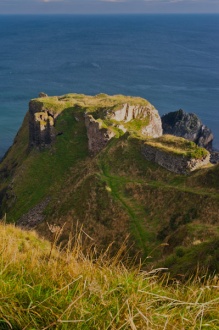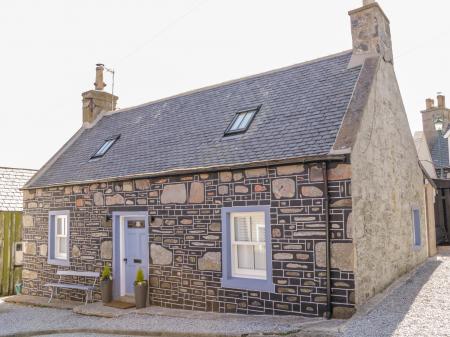
Two deep channels were cut in the rock, each spanned by a drawbridge which could be removed in times of attack. Access to the castle was limited to foot traffic, so a small forecourt enclosure, a simple rectangle of stone, was built on the mainland to receive horses and act as a reception area for visitors.
HISTORY OF FINDLATER
There has been a fortress at Findlater since at least the 13th century. The Danes captured the early castle, of which no certain remnants remain. The current romantic ruin dates to the late 14th century and was probably the work of Sir John Sinclair. The Sinclair seat is at Roslyn, and Findlater appears to have been built in the same style.

The first we hear of the subsequent fortification in written records is 1455 when James II granted Sir Walter Ogilvy a license to expand and strengthen his already existing castle.
Around 1560 Findlater was caught up in the maelstrom of political manoeuvring that surrounded Mary, Queen of Scots and her struggle to assert power over her nobles.
Sir Alexander Ogilvie squabbled with his son, James, and finally disinherited him. Alexander granted Findlater to Sir John Gordon, but James was not going to give up his inheritance so easily.
He used his considerable influence as Steward in the royal household of Mary, Queen of Scots, and convinced Mary to visit the castle. Gordon refused to allow the Queen to enter, so she sent a force of men to seize Findlater. Gordon beat them off, but he was himself captured at the Battle of Corrichie shortly after. He was tried for treason and beheaded, and Findlater was given to Sir James Ogilvie.
By the middle of the 17th century, the castle had become too old-fashioned for the Ogilvie family's needs, and the family built a new and much more comfortable residence at Cullen, just west along the coast.

The castle was left to decay, and decay it certainly has. The ruins are in a poor state of repair, and though you can wander freely around the castle promontory, remember that it is a long way down to the base of the cliffs below, so do take care! But what a ruin! It is hard to imagine a more picturesque site than that occupied by the castle, tucked into the rugged cliffs.
On the cliffs above the castle is a restored doocot, possibly dating to the 16th century, that once provided food for the inhabitants of Findlater Castle. There are about 700 nesting boxes inside the doocot, which is still actively used by local birds.
In case you were wondering, the name 'Findlater' comes from Norse words which loosely translate as 'white cliffs'.
VISITING FINDLATER
Access to Findlater Castle is straightforward; the castle is signposted off the A98 coastal road just west of Sandend. There is a small parking area and a level path leads to the castle site, where there is a small information panel and a lookout point. Alternatively, you can reach Findlater by taking the Moray Coastal Trail from either Cullen or Sandend. A mile to the east along the coast is Crathie Point Promontory Fort.
 We've 'tagged' this attraction information to help you find related historic attractions and learn more about major time periods mentioned.
We've 'tagged' this attraction information to help you find related historic attractions and learn more about major time periods mentioned.




